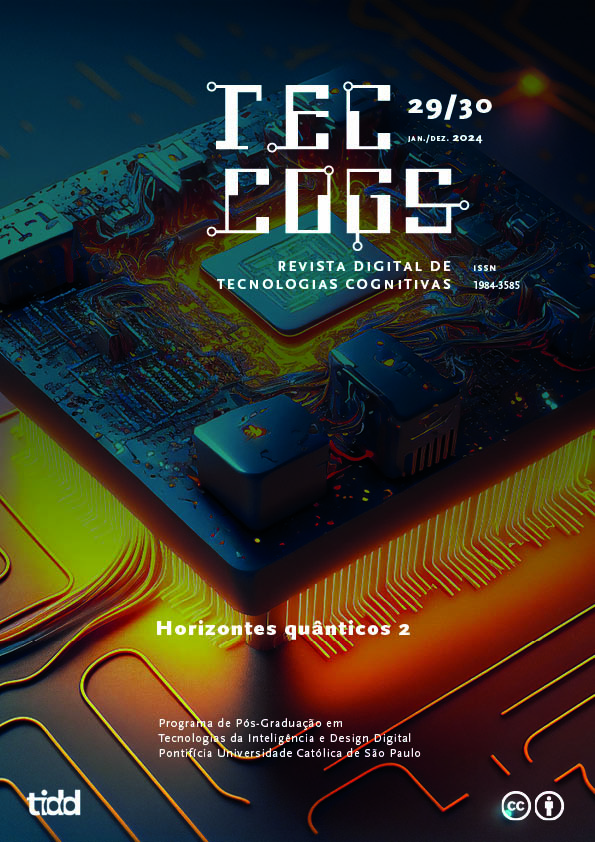O recurso quântico
uma estratégia ficcional
DOI:
https://doi.org/10.23925/1984-3585.2024i2930p96-106Palavras-chave:
quântico, mecânica quântica, ficção científica, multiverso, interpretação de muitos mundosResumo
Nos últimos anos, a palavra “quântico” tem sido utilizada em contextos variados, muitas vezes dissociados de sua origem na física quântica. Termos como “coach quântico” e “cura quântica” são exemplos de como conceitos científicos podem ser desvirtuados para finalidades metafísicas ou pseudocientíficas. Este artigo explora a origem do termo “quântico”, suas bases teóricas na física e seu uso na ficção científica, onde se tornou um recurso narrativo popular. A mecânica quântica, que estuda os fenômenos no nível subatômico, foi desenvolvida por cientistas como Einstein, Bohr, Planck, Schrödinger e Heisenberg. Destacamos o experimento mental do gato de Schrödinger, que ilustra a superposição quântica e o problema da medição. Discutimos também a Interpretação de Muitos Mundos de Hugh Everett, que sugere a existência de universos paralelos. O conceito de multiverso, popularizado na cultura pop por filmes e séries do Universo Cinematográfico Marvel, encontra suas raízes em teorias físicas robustas. No entanto, a ficção científica e outras formas de mídia muitas vezes simplificam ou distorcem esses conceitos para fins narrativos. Ao final, consideramos os benefícios e limitações da apropriação quântica tanto na compreensão científica quanto na criação ficcional.
Referências
DEWITT, Bryce. The many-worlds interpretation of quantum mechanics. Princeton: Princeton University Press, 1973.
EGAN, Greg. Schild’s ladder. London: Gollancz, 2010.
EVERETT, Hugh. “Relative state”-formulation of quantum mechanics. Reviews of Modern Physics, v. 29, n. 3, p. 454-462, 1957.
LANGFORD, David. Quantum computers. The Encyclopedia of Science Fiction, 2024. Disponível em: https://sf-encyclopedia.com/entry/quantum_computers. Acesso em 25/5/2024.
MCDONALD, Ian. Planesrunner (Everness book I). New York: Pyr, 2011.
SCHRÖDINGER, Erwin. The present situation in quantum mechanics. Proceedings of the American Philosophical Society, v. 124, p. 323-338, 1935.
QUANTUM. Dicionário Caldas Aulete, 2024. Disponível em: http://www.aulete.com.br/quantum. Acesso em: 25 maio 2024.
QUANTUM MYSTICISM. Disponível em: <https://en.wikipedia.org/wiki/Quantum_mysticism>. Acesso em: 25 maio 2024.
WUNDERLICH, Marcos. Coaching quântico. Disponível em: <https://www.holos.org.br/coaching-quantico>. Acesso em: 25 maio 2024.
ZEILINGER, Anton. Experiment and the foundations of quantum physics. Reviews of Modern Physics, v. 71, n. 2, p. 288-297, 1997.
Filmografia
A MOSCA DA CABEÇA BRANCA. Direção de Kurt Neumann. Estados Unidos, 20th Century Fox, 1958.
A MOSCA. Direção de David Cronenberg. Estados Unidos, 20th Century Fox, 1986.
HOMEM-ARANHA: NO ARANHAVERSO. Direção de Peter Ramsey, Rodney Rothman e Bob Persichetti. Estados Unidos, Sony Pictures Animation, 2018.
HOMEM-FORMIGA E A VESPA: QUANTUMANIA. Direção de Peyton Reed. Estados Unidos, Marvel Studios, 2023.
JORNADA NAS ESTRELAS. Criada por Gene Roddenberry. Estados Unidos, NBC, 1966-1969.
LOKI. Criada por Michael Waldron. Estados Unidos, Disney+, 2021.
TEOREMA ZERO. Direção de Terry Gilliam. Reino Unido, Voltage Pictures, 2013.
Downloads
Publicado
Como Citar
Edição
Seção
Licença
Copyright (c) 2025 TECCOGS: Revista Digital de Tecnologias Cognitivas

Este trabalho está licenciado sob uma licença Creative Commons Attribution 4.0 International License.
Esta revista oferece acesso livre imediato ao seu conteúdo de acordo com a licença CC BY 4.0, em conformidade com a definição de acesso público do Directory of Open Access Journals (DOAJ).
Ao submeter um texto à TECCOGS, os autores asseguram que o material submetido à avaliação e eventual publicação não infringe de modo algum qualquer direito proprietário ou copyright de outros. Com a submissão, o autor transfere em efetivo os direitos de publicação do artigo para a TECCOGS. A transferência de copyright cobre os direitos exclusivos de publicação e distribuição do artigo, incluindo reimpressões ou quaisquer outras reproduções de natureza similar, além de traduções. Os autores mantém o direito de usar todo ou partes deste texto em trabalhos futuros de sua autoria e de conceder ou recusar a permissão a terceiros para republicar todo ou partes do texto ou de suas traduções. Para republicar números da revista na íntegra, qualquer interessado precisa obter permissão por escrito tanto dos autores como também dos editores da TECCOGS. A TECCOGS por si só pode conceder direitos relativos a emissões de periódicos como um todo.
Imagens com direitos autorais pertencentes a terceiros, que não foram concedidos ao autor do texto, devem ser utilizadas somente quando necessárias à análise e ao argumento da pesquisa, sempre indicando as respectivas fontes e autoria. A TECCOGS dispensa o uso de imagens meramente ilustrativas. Se desejar ilustrar um conceito, o autor deve indicar, em forma de URL ou referência bibliográfica, uma referência em que a ilustração esteja disponível.
---------------------------------------------------------------------------------
This journal offers free immediate access to its content under CC BY 4.0, in accordance with Directory of Open Access Journals' (DOAJ) definition of Open Acess.
When submitting a text to TECCOGS, authors ensure that the material submitted for evaluation and eventual publication does not infringe any proprietary right or copyright. Upon submission, authors effectively transfer the publication rights of the article to TECCOGS. The copyright transfer covers the exclusive rights of publication and distribution of the article, including reprints or any other reproduction of similar nature, in addition to translations. Authors retain the right to use all or parts of the text in future works of their own, as well as to grant or refuse permission to third parties to republish all or parts of the text or its translations. In order to fully republish issues of the magazine, anyone interested must obtain written permission from both the authors and the editors of TECCOGS. TECCOGS alone can grant rights relating to issues of journals as a whole.
Images whose copyright belongs to third parties that have not been granted to the author of the text should be used only when essential for the analysis and argument, always indicating theirs respective sources and authorship. TECCOGS dismisses any use of merely illustrative images. To illustrate a concept, the author must indicate, in the form of a URL or bibliographic reference, a source in which the illustration is available.


